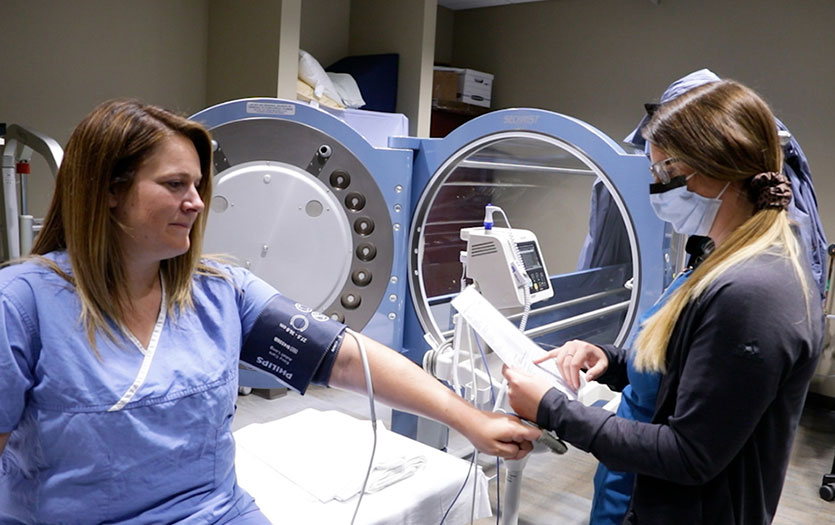
The providers at Parkview’s Centers for Wound Healing are using state-of-the-art therapies to reintroduce the body’s innate ability to heal chronic wounds. One such therapy provided is hyperbaric oxygen therapy (HBOT), which can be used to save limbs from amputation. Susan Oedy, practice manager, PPG – Wound Care, and James Edlund, MD, medical director, PPG – Wound Care, tell us more.
What is hyperbaric oxygen therapy (HBOT)?
HBOT is when a patient breathes pure oxygen in a pressurized environment. This environment helps the blood transport more oxygen around the body to promote healing from the inside out.
More scientifically, HBOT involves an individual sitting in a chamber breathing near 100% medical grade oxygen (99+%) under a pressure of at least 1.4 times the pressure at sea level. The typical treatment at Parkview uses 2 or 2.5 times the pressure at sea level for about 90 minutes at a time. Most patients receive 30 to 40 such treatments, which are 5 days a week for 6 to 8 weeks.
Oxygen at 100% under twice the pressure of room air dissolves in the plasma 10 to 12 times more easily than at sea level pressure. This dissolved oxygen results in an increased delivery of oxygen to the tissues (the increase is not from more being carried by red blood cells, which are typically completely saturated already). There have been experiments in which animals were kept alive and functioning with no red blood cells at all under three atmospheres of 100% oxygen.
What does the patient experience in HBOT?
HBOT is a non-invasive procedure. Patients come in and watch television while sitting in a bed encased in a large, see-through plastic shell surrounded by oxygen that’s at a higher-than-normal atmospheric pressure. The only sensation patients experience is a slight pressure in the ears, as you would on an airplane, when the pressure changes.
What does HBOT treat?
There are currently 14 approved indications that can be treated with hyperbaric oxygen therapy. Most of what HBOT is used to treat at Parkview’s Centers for Wound Healing are wounds that have not responded to traditional therapy. Common wounds we treat include diabetic foot ulcers, osteomyelitis (inflammation of the bone or bone marrow), or late post-radiation complications including soft tissue radionecrosis or osteoradionecrosis.
Are there potential risks?
As with most medical procedures there is a risk for potential complications with HBOT. The most common complication is barotrauma to the tympanic membrane (or a pressure imbalance between the inside of the ear and the outer environment). Some patients require ear “tubes” for decompression, which can be administered by an ENT provider.
Occasionally, confinement anxiety is serious enough to prevent a patient from receiving HBOT.
There are also potentially serious consequences with heart failure or chronic lung patients receiving HBOT, so the wound care team works closely with cardiology and pulmonary providers to mitigate those risks.
Patients with diabetes can also see their blood glucose levels drop by 30-40% during treatment. It’s recommended they begin treatment with blood glucose levels that are sufficiently high to account for the possible drop.
Another possible complication, oxygen toxicity, is avoided by using “air breaks,” as needed. This is done by having the patient breathe room air through a mask while still in the chamber for 5 minutes twice during each session.
Is HBOT covered by insurance?
Hyperbaric oxygen therapy treatments are typically covered by Medicare, Medicaid, and most insurance plans. The Parkview Center for Wound Healing also welcomes self-referrals.
Final thoughts
Chronic wounds affect more than 8 million people in the United States and the incidence is rising, fueled by an aging population and increasing rates of diseases and conditions such as diabetes, obesity and the late effects of radiation therapy.
In addition to HBOT, Parkview’s Centers for Wound Healing at Parkview Hospital Randallia, Parkview Noble Hospital and Parkview Huntington Hospital also offer negative pressure therapies, bioengineered tissue and bio synthetics to treat chronic wounds.
For more information, please contact the location nearest you:
Parkview Randallia: 260-373-6070
Parkview Noble: 260-347-8610
Parkview Huntington: 260-355-3170



